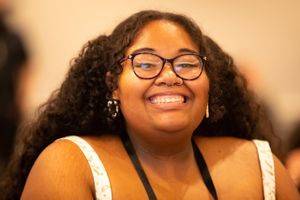NATIONAL MUSEUM OF NATURAL HISTORY
Community Archeology Helps Bridge Gap Between Science and Tradition
Researchers and Indigenous people teamed up to use oral legends and science to discover an archeology site
:focal(800x533:801x534)/https://tf-cmsv2-smithsonianmag-media.s3.amazonaws.com/filer_public/84/45/84455a44-2b32-4423-a1b9-457fe2f46309/the_hubbard_glacier_in_disenchantment_bay_alaska_in_june_of_2022.jpg)
When archeologist Aron Crowell volunteered at the National Museum of Natural History in the 1970’s with curator William Fitzhugh, his life changed trajectory.
While still a student at George Washington University, Crowell delved into Arctic archeology and became impassioned with bridging archeological knowledge with the expertise passed down in Indigenous people’s oral histories.
“I’m interested in connecting the history as people in those communities remember it and pass it on to younger generations over many generations, even centuries, and comparing it to archeological evidence,” Crowell said.
Crowell now has the opportunity to do just that as the Alaska Director of the Smithsonian Institution's Arctic Studies Center. Most recently, his work has centered on the snowcapped, glacier-covered Yakutat region of Alaska as part of the center’s Yakutat Bay Project.
/https://tf-cmsv2-smithsonianmag-media.s3.amazonaws.com/filer_public/78/b0/78b01639-0cc6-4be9-8cfc-95e1f7314963/aron_crowell_at_aialik_glacier_2004.jpg)
The cultural ecology of this stretch of Alaska’s coast, which is home to a rich ecosystem of moose, seabirds and marine mammals, is unmatched according to Crowell.He knew he wanted to dive deeper into the history of the peoples who have been living there for generations. “The oral knowledge people have about their history is extraordinarily detailed and accurate,” Crowell said. “You can find evidence of migrations, establishments of villages, volcanic eruptions that have interrupted people’s lives.”
Guided by oral stories of the local Tlingit People, Crowell and his team uncovered the site of a 500-year-old village littered with arrow points and other artifacts in 2011. But this was far from a standard archeological excavation, where researchers usually travel to a site, dig up artifacts and then return to their museums or universities. Crowell and his colleagues were focused on partnering with the local Tlingit community. By listening to their stories, observing their language and being transparent, Crowell’s team formed a relationship built on mutual trust and understanding, helping the Tlingit People tell their own stories.
This excavation is an example of a larger archeological trend called community archaeology which is a form of research focused on collaborating with locals including community groups, descendants, elders, and local historians. Throughout history, archaeology has been tied more to physical artifacts rather than to people; including the people whose cultures are tied to the sites. One person who played a crucial role in fostering the Tlingit community’s participation in the Alaskan excavation was Judith Ramos, a citizen of the Yakutat Tlingit clan and anthropologist at the University of Alaska Fairbanks. As part of her PhD in Indigenous studies, Ramos worked with Crowell and helped facilitate open conversation and connection between her community and the Smithsonian researchers.
According to Ramos, one of her most important tasks was ensuring that the researchers understood and respected the “natural rhythm of the community.” During the summertime, when the expedition took place, the tribe’s day to day activities consisted of gathering food and preparing for the harsher winter months. This presented some challenges for the researchers.
“They wanted to do interviews, but I had to find who was in town, who was at fish camp,” Ramos said. “They didn’t understand that the community had their own priorities and research wasn’t one of them.”
/https://tf-cmsv2-smithsonianmag-media.s3.amazonaws.com/filer_public/63/19/63193adc-c8b4-40ea-9a6e-80fa639fd457/screen_shot_2022-10-28_at_34250_pm.png)
While research wasn’t on the minds of many of the tribal citizens at first, Ramos said it became clear that the community was interested in helping with the project once asked. Ramos and her mother, Elaine Abraham, a senior matriarch of the Tlingit community, facilitated conversations between the tribe and the researchers. They also set up presentations to update the community on the ongoing research project. “I tried to be a diplomat with the guidance of my mother who is used to dealing with scientists as part of the Alaska Native Science Commission,” Ramos said.
In addition to including the community’s elders, the archeological team also aimed to get the younger Tlingit generations involved with the work. Children were brought to the archaeological site and were able to take part in the digging and research and further learn about their ancestor’s way of life 500 years ago.
Structures found at the site included dwellings and smoke houses with hearths to cure meats and provide stable sustenance for the village. Using reconstruction tools, Crowell’s team gave presentations on what the structures may have actually looked like based on the remains and materials available at the time of construction.
The researchers also uncovered an ancient toolbox of artifacts including arrow points for hunting, microblades and knives, carving chisels, scrappers and other toolsCrowell shared these ancient tools with the community. Locals could see the chert micro awls used to pierce leather and cobble spall tools used to process seals that their ancestors used.
/https://tf-cmsv2-smithsonianmag-media.s3.amazonaws.com/filer_public/b8/b9/b8b9d0de-d0af-4213-95d2-fde05a45b81f/screen_shot_2021-01-28_at_42158_pm.jpg)
But the most memorable part of the community collaboration project for Ramos was when Crowell and other scientists recorded elders in the community sharing their language and oral legends. According to Ramos, many of these elders have since passed and the work that Crowell and his team did will benefit future generations of the Tlingit community well into the future.
In the spirit of bridging research and tradition, Abraham led a ceremony to heal the dig site and pay respect to the people who once inhabited these lands. According to Crowell, this was one of the most meaningful and beautiful experiences he had ever encountered on one of his research endeavors.
“The community recognized this ancestral place that we helped to rediscover and learn about,” he said. “It was joyful for people to call out the names [of their ancestors] and dance and to sing one of their migration songs which is 500 years old. To me, that was a peak moment.”
Related Stories:
Archaeologists Identify Famed Fort Where Indigenous Tlingits Fought Russian Forces
This Replica of a Tlingit Killer Whale Hat Is Spurring Dialogue About Digitization
How Arctic Anthropologists are Expanding Narratives about the North

